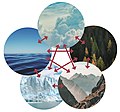Cryosphere
Cryosphere refers to the portions of Earth's surface where water is in solid form, including sea ice, lake ice, river ice, snow cover, glaciers, ice caps, ice sheets, and frozen ground (which includes permafrost). The cryosphere is an integral part of the global climate system, with important connections and feedbacks generated through its interactions with the atmosphere, ocean, and biosphere. The cryosphere plays a critical role in Earth's climate by reflecting solar radiation (albedo effect) and regulating surface temperature. It also contributes to global sea level rise through the melting of glaciers and ice sheets.
Components of the Cryosphere
Sea Ice
Sea ice forms from the freezing of ocean water. It affects the movement of ocean waters and is an important habitat for polar wildlife.
Glaciers and Ice Sheets
Glaciers are large, flowing masses of ice that form where the accumulation of snow exceeds its ablation (melting and sublimation) over many years. Ice sheets, found in Greenland and Antarctica, are continental-scale ice masses that cover land surface.
Permafrost
Permafrost is ground, including rock or soil, that has been frozen for more than two consecutive years. It plays a key role in the carbon cycle and can release greenhouse gases upon thawing.
Snow Cover
Snow cover refers to the layer of snow that accumulates on the ground in polar and temperate regions. It influences Earth's temperature by reflecting sunlight and insulating the surface.
Importance of the Cryosphere
The cryosphere influences the global climate system in several ways. It reflects a significant amount of solar radiation back into space, which helps to regulate Earth's temperature. The cryosphere also contributes to global sea level rise through the melting of ice. Additionally, it is a critical source of freshwater for many regions and supports diverse ecosystems.
Changes in the Cryosphere
Observations show that the cryosphere is undergoing significant changes due to global warming. These changes include the shrinking of glaciers, the thinning of ice sheets, the reduction of sea ice, and the thawing of permafrost. These changes have profound impacts on global sea levels, weather patterns, and ecosystems.
Challenges and Future Directions
The ongoing changes in the cryosphere present significant challenges for scientists, policymakers, and communities. Predicting the future state of the cryosphere requires sophisticated climate models and a comprehensive understanding of the complex interactions between the atmosphere, oceans, and ice. Efforts to mitigate the impacts of cryosphere changes include reducing greenhouse gas emissions, protecting vulnerable ecosystems, and developing adaptive strategies for communities at risk.
Lua error in package.lua at line 80: module 'strict' not found.
| Glaciology | ||||||||||
|---|---|---|---|---|---|---|---|---|---|---|
This glaciology related article is a stub.
|
Cryosphere
Transform your life with W8MD's budget GLP-1 injections from $125.
W8MD offers a medical weight loss program to lose weight in Philadelphia. Our physician-supervised medical weight loss provides:
- Most insurances accepted or discounted self-pay rates. We will obtain insurance prior authorizations if needed.
- Generic GLP1 weight loss injections from $125 for the starting dose.
- Also offer prescription weight loss medications including Phentermine, Qsymia, Diethylpropion, Contrave etc.
NYC weight loss doctor appointments
Start your NYC weight loss journey today at our NYC medical weight loss and Philadelphia medical weight loss clinics.
- Call 718-946-5500 to lose weight in NYC or for medical weight loss in Philadelphia 215-676-2334.
- Tags:NYC medical weight loss, Philadelphia lose weight Zepbound NYC, Budget GLP1 weight loss injections, Wegovy Philadelphia, Wegovy NYC, Philadelphia medical weight loss, Brookly weight loss and Wegovy NYC
|
WikiMD's Wellness Encyclopedia |
| Let Food Be Thy Medicine Medicine Thy Food - Hippocrates |
Medical Disclaimer: WikiMD is not a substitute for professional medical advice. The information on WikiMD is provided as an information resource only, may be incorrect, outdated or misleading, and is not to be used or relied on for any diagnostic or treatment purposes. Please consult your health care provider before making any healthcare decisions or for guidance about a specific medical condition. WikiMD expressly disclaims responsibility, and shall have no liability, for any damages, loss, injury, or liability whatsoever suffered as a result of your reliance on the information contained in this site. By visiting this site you agree to the foregoing terms and conditions, which may from time to time be changed or supplemented by WikiMD. If you do not agree to the foregoing terms and conditions, you should not enter or use this site. See full disclaimer.
Credits:Most images are courtesy of Wikimedia commons, and templates, categories Wikipedia, licensed under CC BY SA or similar.
Translate this page: - East Asian
中文,
日本,
한국어,
South Asian
हिन्दी,
தமிழ்,
తెలుగు,
Urdu,
ಕನ್ನಡ,
Southeast Asian
Indonesian,
Vietnamese,
Thai,
မြန်မာဘာသာ,
বাংলা
European
español,
Deutsch,
français,
Greek,
português do Brasil,
polski,
română,
русский,
Nederlands,
norsk,
svenska,
suomi,
Italian
Middle Eastern & African
عربى,
Turkish,
Persian,
Hebrew,
Afrikaans,
isiZulu,
Kiswahili,
Other
Bulgarian,
Hungarian,
Czech,
Swedish,
മലയാളം,
मराठी,
ਪੰਜਾਬੀ,
ગુજરાતી,
Portuguese,
Ukrainian
Contributors: Prab R. Tumpati, MD









